職人・作品紹介
貝澤 徹 Toru Kaizawa
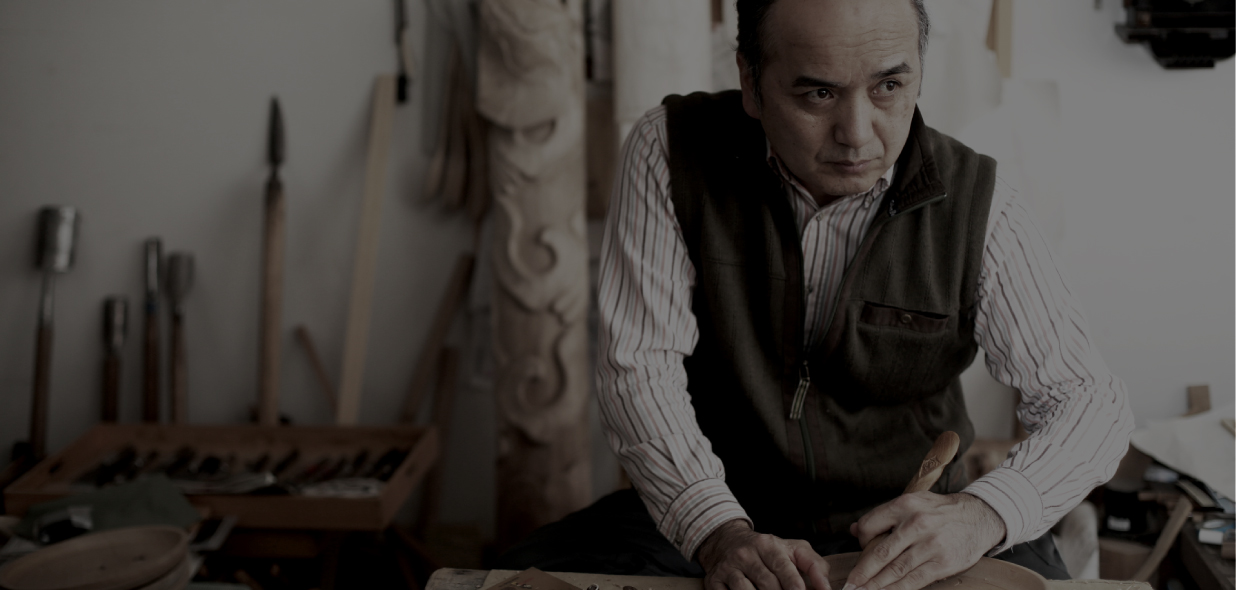
1958年、二風谷に生まれ、工芸家の父(勉)やその仲間の職人に囲まれて育つ。 曾祖父の貝澤ウトレントクは、明治時代に名工といわれた二人のうちの一人。その曾祖父から引き継ぐ伝統を重視しながら、そこに独自の感性と技術をとけ込ませ、自分らしさやメッセージを表現する、独創的なアイヌアートに精力的に取り組んでいる。ふと気づいたことを題材に作品を創作。代表作「UKOUKU(ウコウク)/輪唱」は、昔のアイヌ民族の入れ墨をした女性の手の写真から発想し、世代交代しながら文化が受け継がれるというメッセージをこめて創り上げた。北海道アイヌ伝統工芸展北海道知事賞ほか受賞多数。「北の工房 つとむ」店主。
Born in Nibutani in 1958, he grew up in the company of his craftsman father (Tsutomu) and his fellow artisans. His great-grandfather, Utorentoku Kaizawa was one of the two artisans renowned for their skill in the Meiji Era. Whilst valuing the traditions inherited from his great-grandfather, he melds into them his unique sensibility and techniques, energetically grappling with the creation of original Ainu art that expresses his own personality and message. Flashes of inspiration provide the subjects for his works. The idea for his famous 'UKUOKU/ The Round" came from a photograph of a woman's arm with an ancient Ainu tattoo, and was created with the message that culture is passed down through the generations. He has won many prizes, including the Hokkaido Governor's Award at the Hokkaido Ainu Traditional Craft Exhibition. He is the owner of Kita no Kobo Tsutomu.
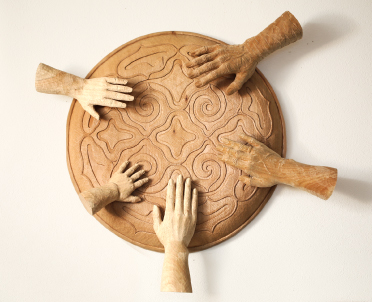
ウコウク
Ukouk
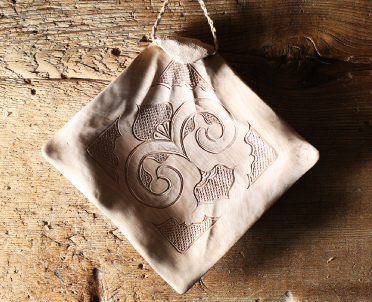
樹布
Jufu

マキリ
Makiri
洲崎 春男 Haruo Suzaki
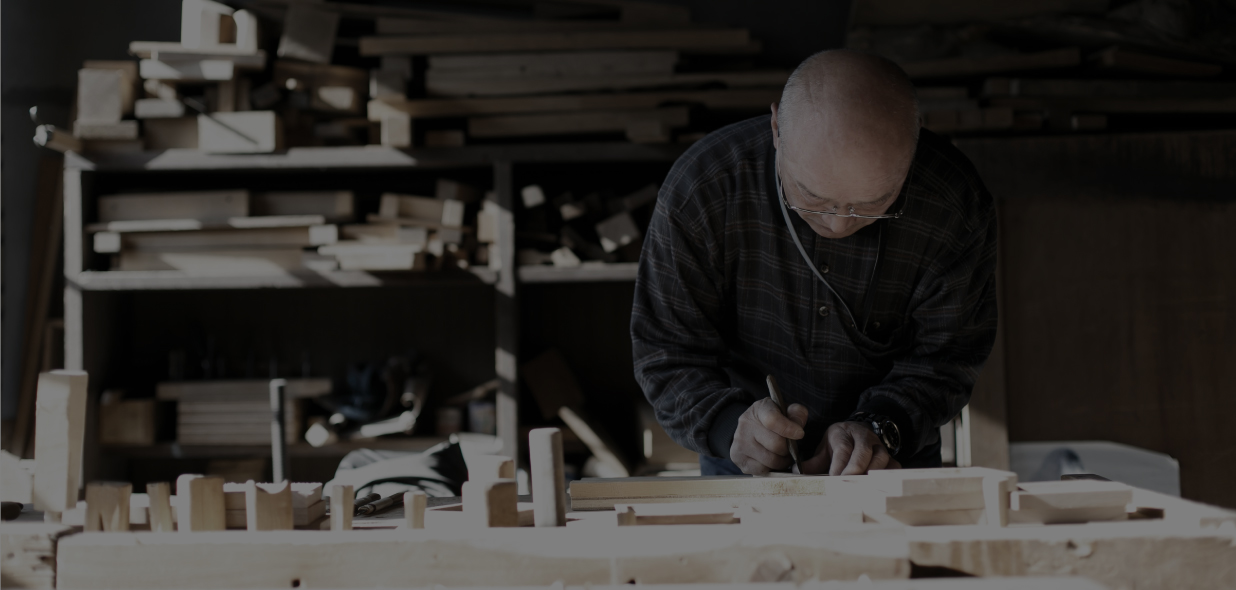
大阪出身。19歳から北海道に移住して、元北海道ウタリ協会副理事であった貝澤正氏のもとで働き、24歳から木彫りを始めた。大胆で力強い彫りと繊細なアイヌ文様が融合し、洲崎春男独自の世界観が作品として生み出されている。カムイ(神)へ祈りを伝える道具イクパスイ(捧酒箸)とトゥキ(杯)などは、神々しいほどの異彩を放つ。木目の美しさが際立つクルミのコースターやニマ(器)も人気。手作りの道具1つひとつにも、洲崎春男の作品づくりへの思いがこめられている。
Born in Osaka. He moved to Hokkaido at the age of 19, worked under Tadashi Kaizawa deputy chairman of the former Hokkaido Utari Association, and started woodcarving at the age of 24. He fuses bold, powerful carving with delicate Ainu patterns to create works that are redolent of the unique world of Haruo Suzaki. Particularly sublime are items such as the iku-supai (prayer stick) and tuki (cup), implements used to convey prayers to the kamuy (god). Also popular are his walnut coasters and nima (bowls), which bring out the beauty of the wood's grain. Haruo Suzaki's passsion for his craft imbues each one of his handmade implements.
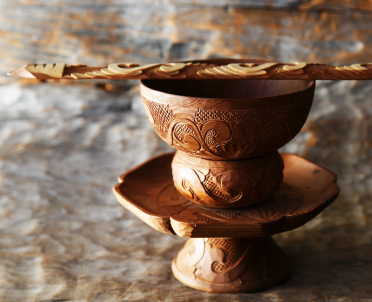
トゥキ・イクパスイ
Tuki, Iku-pasuy
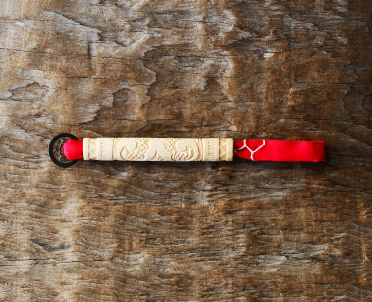
チシポ
Cispo
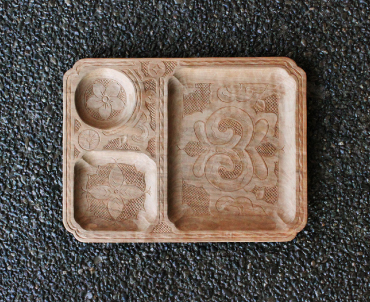
イタ
Ita
貝澤 守Mamoru Kaizawa
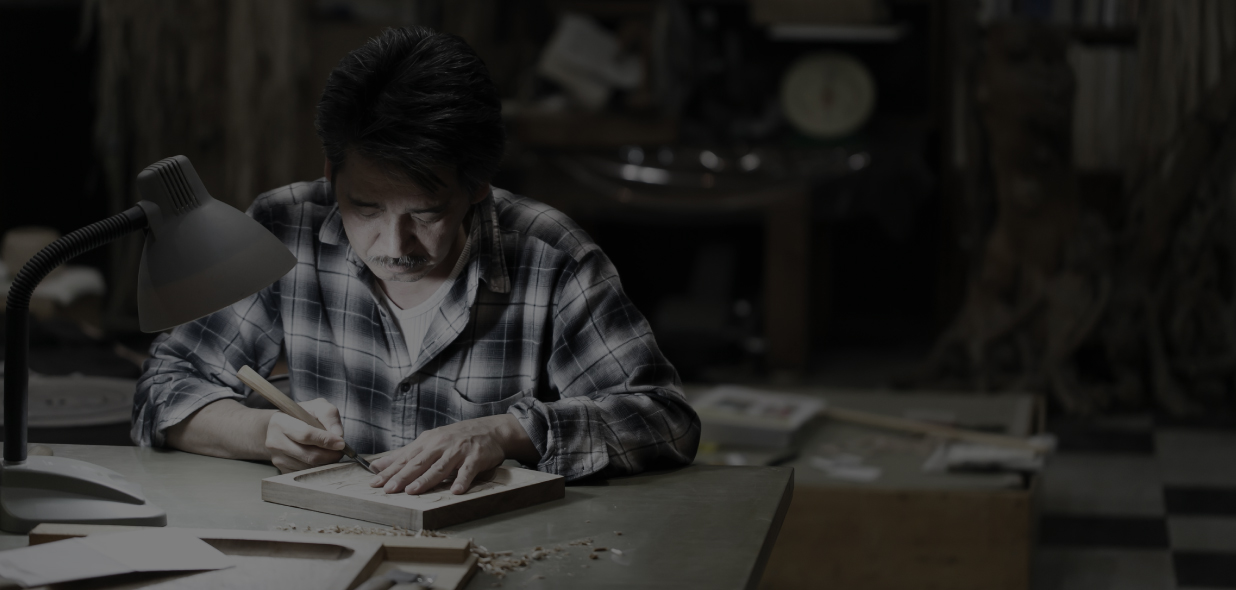
幼少時代より、木彫職人であった父・守幸(1977年没)の彫刻を見て育った。守が12歳のとき父が亡くなり、高校卒業後は一時期札幌で暮らしたが、ふるさとへ戻り21歳から工芸作品を作り続けている。二風谷のイタ(盆)には、先人の味わい深い技が生き残っていると、その伝承に努めながら、独自の作品づくりに力を注いでいる。特に、ラムラムノカ(ウロコの文様)は、ノミを木に対して鋭角に入れることで陰影を出す、繊細で美しい彫り込みが特徴だ。アイヌ文様を施した革製品、鹿角を彫り込んだフクロウのストラップやペンダントも人気。
2010年に、国土緑化推進機構のコンクール・森の伝承・文化部門で「森の名手・名人」に全国で80人、道内でただ一人選ばれたアイヌ伝統工芸作家である。「貝沢民芸」店主。
He grew up surrounded from childhood by the carvings produced by his woodcarver father Moriyuki (died in 1977). Mamoru was 12 when his father died and, although he did live in Sapporo for a while after graduating from high school, he returned to his home town at the age of 21, since when he has continued to create handicraft products. The profound techniques of past generations of craftsmen live on in the ita (trays) of Nibutani, and he pours his energies into creating original works whilst also trying to pass on that tradition. He is particularly noted for his delicately beautiful Ramuramunoka (fish-scale pattern) carvings, where he creates shading by inserting the chisel into the wood at an acute angle. His leather goods embossed with Ainu patterns and mobile phone straps with owls carved out of antlers are also popular. In 2010 he was the only traditional Ainu craftsman selected from Hokkaido amongst the 80 people from all over Japan designated as "Masters of the Forests" in the cultural category of the National Land Afforestation Promotion Organization Contest: Traditions of the Forest. He is the owner of Kaizawa Mingei.

メノコマキリ
Menoko-makiri
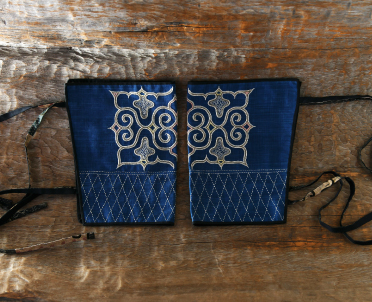
ホシ
Hos
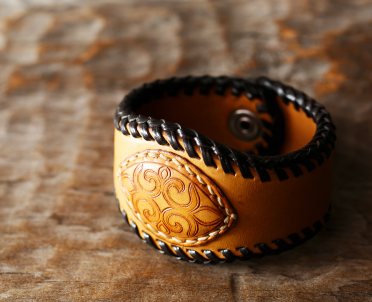
アイヌ文様ブレスレット
Bracelet of ainu pattern
尾崎 剛 Tsuyoshi Ozaki
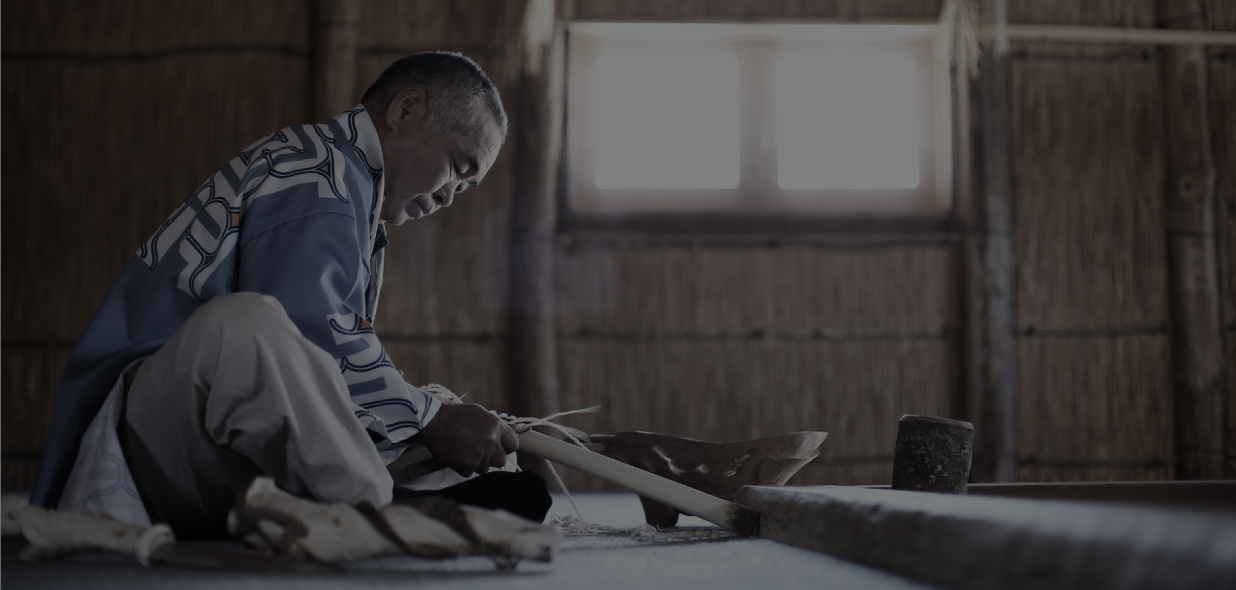
鮭レリーフ・メノコ(女)レリーフなどの木彫り職人として活躍し、オリジナル作品づくりに取り組む一方、地元・二風谷をはじめ日本各地で、チセ造りの第一人者として熱心に取り組んでいる。二風谷でもチセ造りの技術は長く途絶えたままだった。アイヌ振興に命をかけて尽くした故・萱野茂氏と、各地のチセ造りに参加し、技術や知識を体で覚えた。 夢は、二風谷の博物館の敷地にチセを連ね、かつてのにぎわいを取り戻すこと。ふるさとへの誇りと技術伝承・後輩育成への情熱が、活動の源泉になっている。
He is well-known as an engraver of salmon and menoko (woman) bas reliefs and, while working on his own original creations, he works enthusiastically both in his home town of Nibutani and throughout Japan as the leading expert on cise construction. Even in Nibutani the techniques of cise construction had long been lost. Along with the late Shigeru Kayano, who devoted his life to promoting Ainu culture, he took part in cise construction in various different areas and learned the techniques and lore by experience. His dream is to build rows of cise in the grounds of the Nibutani museums and bring back the bustling vitality of the past. His activities are fueled by his pride in his home town and zeal to pass on traditions and train successors.
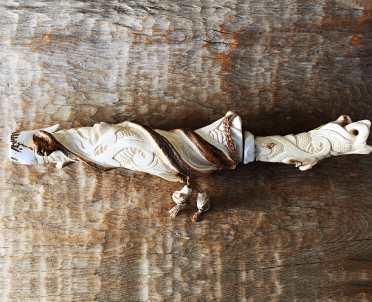
タシロ
Tasiro
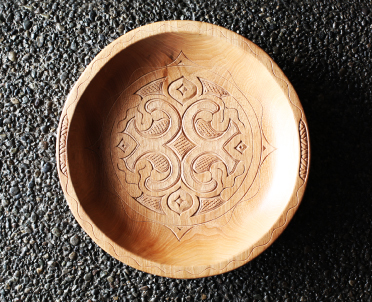
イタ
Ita
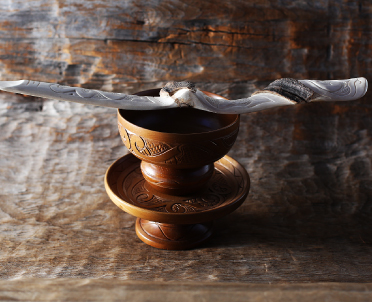
トゥキ・イクパスイ
Tuki, Iku-pasuy
高野 繁廣 Shigehiro Takano
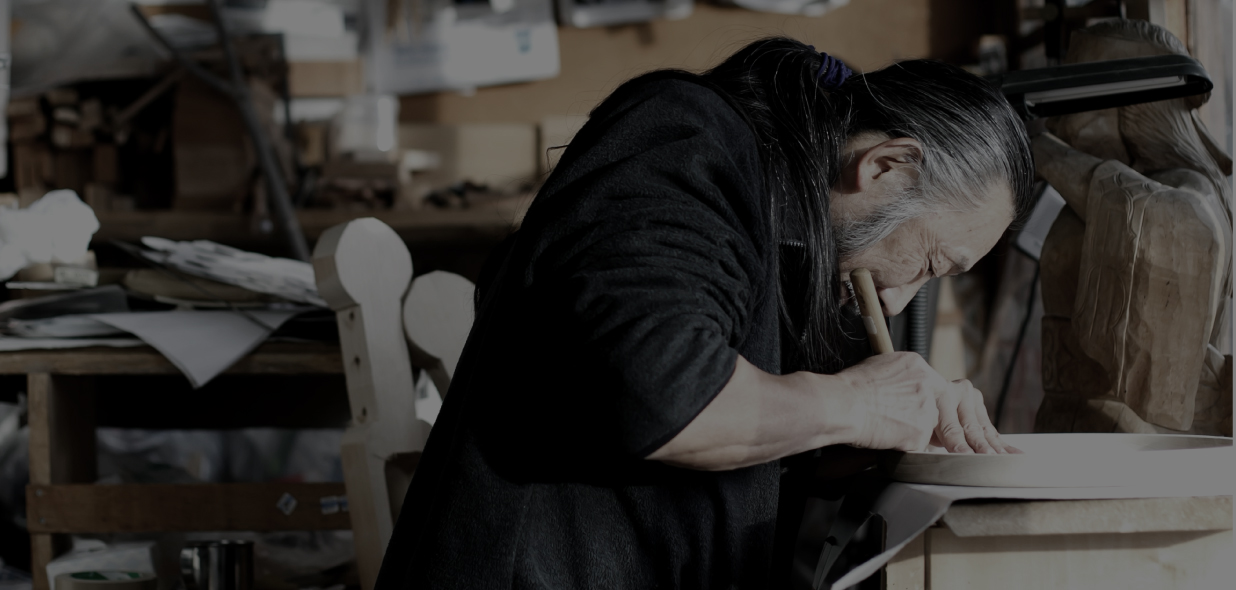
東京都出身。20代の旅の途中、たまたま二風谷に立ち寄り、美しい木彫りに心惹かれた。人々があたたかいこの場所で生きていきたいと移住を決意し、1972年に木彫り職人・貝澤守幸門下で木彫り修行を始めた。1979年に独立し、翌80年に「高野民芸」を創業。アイヌの伝統工芸、伝統文様に深くこだわり、名工の図柄を学びながらイタ(盆)、ニマ(器)、マキリ(小刀)の制作に精魂を傾ける。特に、アイヌに伝わる伝統的な五弦琴であるトンコリは、現在二風谷では高野しか作ることができない、貴重な技術だ。また、全国で個展を開催し、アイヌ工芸品の魅力のPRにも努めている。全道アイヌ民芸工芸品コンクールで最優秀知事賞など受賞多数。「高野民芸」店主。
Born in Tokyo. While travelling in his 20s he happened to drop by Nibutani and was fascinated by the beautiful woodcarvings. Drawn by the warmth of its people, he decided that this was where he wanted to live and moved to Nibutani. In 1972 he started to learn his craft from the woodcarver Moriyuki Kaizawa. He finished his apprenticeship in 1979 and established Takano Mingei in 1980. He is profoundly loyal to traditional Ainu handicrafts and designs, and devotes himself to producing ita (trays), nima (bowls) and makiri (knives) whilst studying the designs of skilled artisans. In particular, Shigehiro Takano is the only person in Nibutani today who has mastered the precious techniques required to make the tonkori, a traditional five-stringed instrument that has been handed down in Ainu culture. He holds solo exhibitions throughout Japan and works hard to publicize the charms of Ainu crafts. He has won many prizes, including the Governor's Award for Excellence at the All-Hokkaido Ainu Folk Crafts Contest. He is the owner of Takano Mingei.
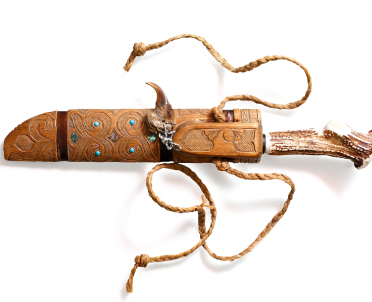
タシロ
Tasiro
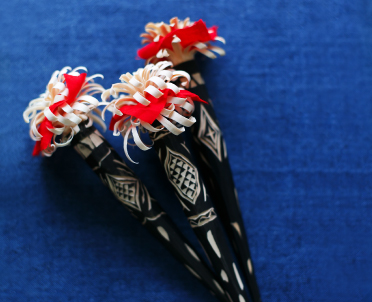
ヘペライ
Heper-ay
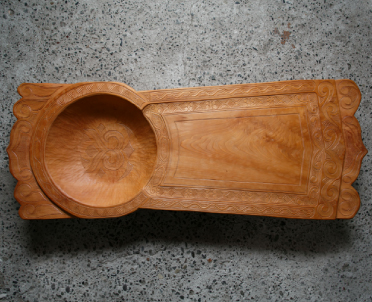
メノコイタ
Menoko-ita
貝澤 雪子 Yukiko Kaizawa
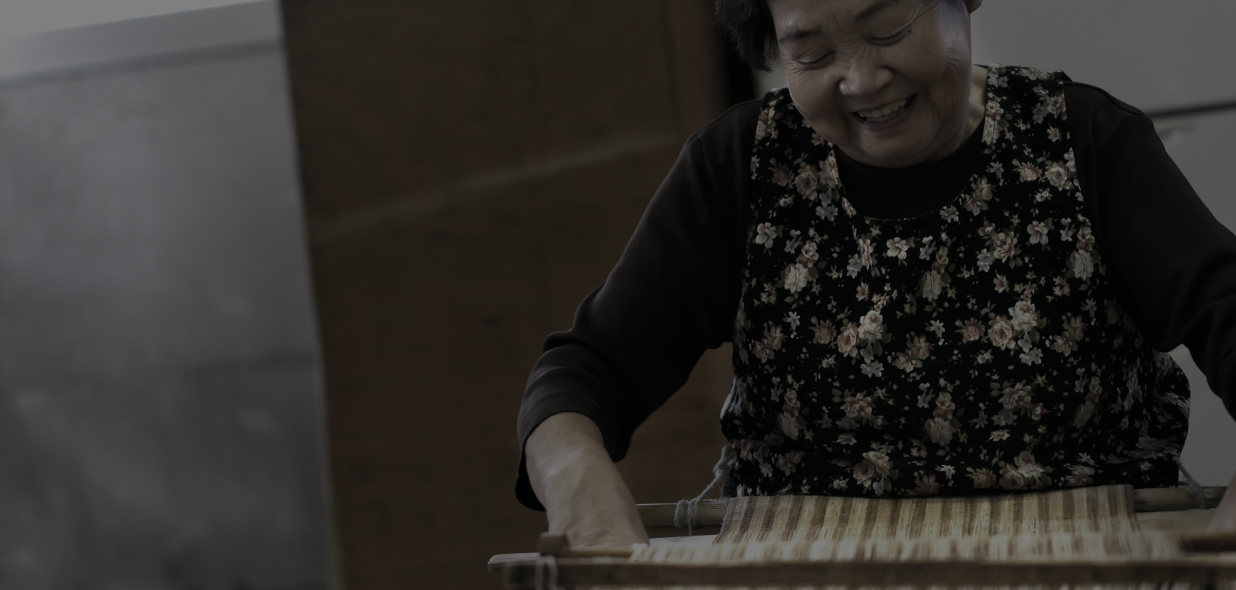
アットゥㇱ織りを半世紀以上にわたり手がけているㇱ。オヒョウの皮で作るアットゥㇱを、キハダの樹皮やアカネ、クルミなど身近な花と草木で染める。染色すると糸がごわつき、織りづらいが「難しい方がやりがいがある」と挑み続けている。淡い色合いの糸で作るしま模様の帯やバッグ、財布などが美しく、全国から注文が舞い込む。1日12時間以上、仕事することもあるが「織るのが好きなので苦痛に感じない」。織れば織るほど、より良いものを作りたくなり、「死ぬまで勉強」が口グセだ。2011年には、北海道アイヌ協会より「優秀工芸師」としても認定されており、受賞歴も多数。アイヌ文化の伝承・保存、後継者の育成に尽力的に取り組んでいる。
She has more than 50 years of experience in weaving attus. She dyes the attus made from lobed elm bark with flowers and plants that grow locally like marigolds, madders and walnuts. The yarn stiffens when it is dyed and is hard to weave, but she continues to take up the challenge, saying that "it's more satisfying when it's difficult". Orders flood in from all over Japan for the beautiful striped obi belts, bags and purses she makes with pale-hued yarn.She sometimes works more than 12 hours a day but says, "it's no hardship because I love weaving". The more she weaves, the more she wants to create good items, and she always says that it is "life-long study".She was also recognized as "an excellent craftswoman" by The Ainu Association of Hokkaido in 2011 and has won many awards.She is vigorously engaged in transmitting and preserving Ainu culture, and in training the next generation of artisans.
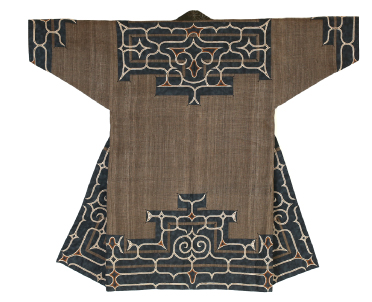
アットゥㇱ・アミプ
Attus-amip
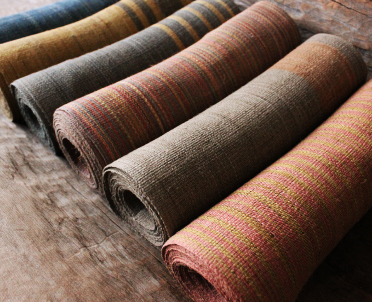
アットゥㇱ織 帯
Girdle of Attus
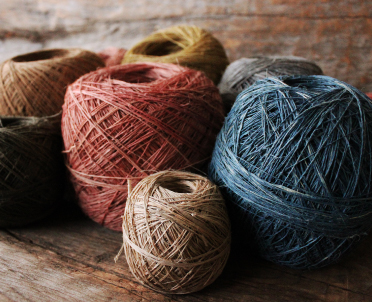
カタク
Katak
藤谷 るみ子Rumiko Fujiya
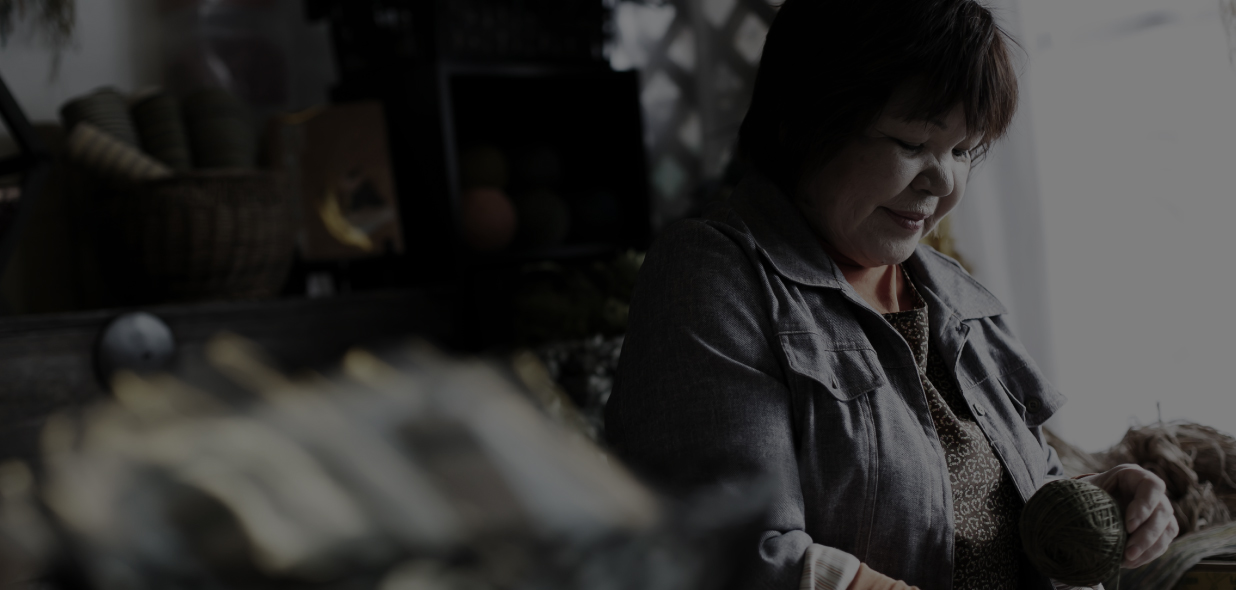
いまでは二風谷でも数少なくなったアットゥㇱ織(樹皮の繊維を織った反物)の技術伝承者。
子どもの頃は、二風谷のどの家庭でも織られていたため、藤谷も母親の糸づくりを小さいときから手伝っていた。中学3年のときに、入院中の母親の代わりに織ったのをきっかけに、本格的に機織りを始める。
アイヌ文様などについては、萱野茂氏の妻・れい子氏の指導を受けた。独自の風合いや色合いを映すアットゥㇱ織の着物や袋などの小物、ていねいに刺繍された色鮮やかなコースターなどが人気。1967年、木彫り職人の藤谷憲幸氏と結婚。2007年、憲幸氏他界後も二風谷で職業訓練指導員(織り布科)として後進の指導に力を注ぐ。
北海道アイヌ伝統工芸展北海道ウタリ協会理事長賞など受賞作品多数。「藤谷工芸」店主。
She is a practitioner of traditional attus (textiles woven from tree bark fibers) techniques, few of whom remain even in Nibutani. During her childhood these textiles were woven in every Nibutani household, so she helped her mother to make the yarn from an early age. She started to weave in earnest when she was in her third year at junior high school and took over the task of weaving when her mother was hospitalized. She was taught about Ainu patterns by Shigeru Kayano's wife Reiko. Her clothing, bags and other accessories made of attus textiles with their unique texture and hues are very popular, as are items such her carefully embroidered brightly-colored coasters. In 1967 she married the woodcarver Noriyuki Fujiya. Since Noriyuki's death in 2007 she has devoted her energies to mentoring the next generation in Nibutani as a vocational training instructor (in weaving and textiles). She has won many awards, including Hokkaido Utari Association Chairman's Award at the Hokkaido Ainu Traditional Craft Exhibition.
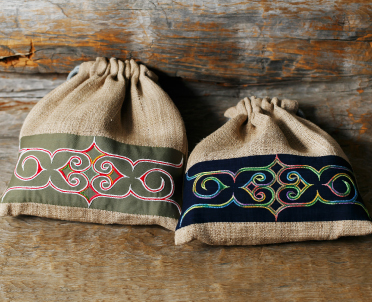
アットゥㇱ織 巾着
Pouch of Attus
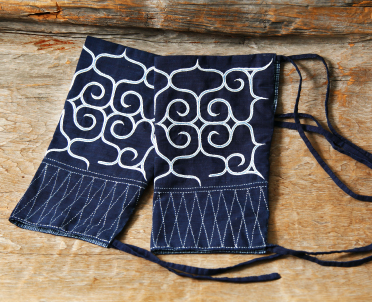
ホシ
Hos
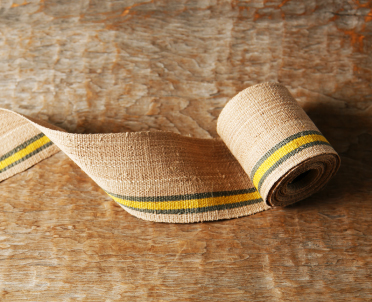
アットゥㇱ織 帯
Sash of Attus
関根 真紀 Maki Sekine
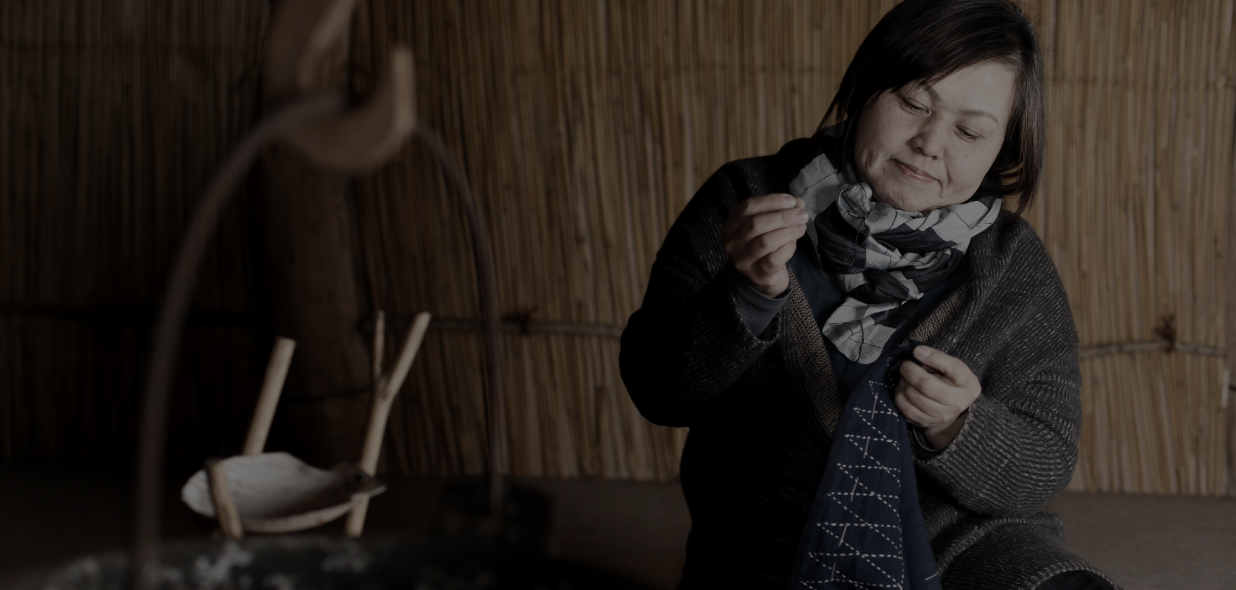
祖父母の代よりアイヌの文化や工芸にふれながら育ち、自然に心惹かれて木彫り、アットゥㇱ織り、アイヌ文様の刺繍などの技術を身につけた。より多くの人たちにアイヌ文化の魅力を知ってもらいたいと、オールマイティに多彩な作品を手がけている。お客さまとの対面方式で作り上げることが多いため、その方のイメージやご要望に沿ったオリジナル作品が生まれる。
伝統的な文様、技法を基にしながら新しいアレンジを加えたり、日常で気軽に使える小物づくり、味わいのあるポストカード制作などに精力的に挑んでいる。また、二風谷の文化を全国、世界へアピールして次世代へ繋げるため、二風谷の広報活動にも積極的に力を注ぎ、職人たちの思いや制作過程の難しさなども伝えている。「アイヌ文化の基本は、家族への愛。その思いがこもった作品でたくさんの人たちが喜びや幸せを感じてくれたら、うれしい」と語る。
She came into contact with Ainu culture and crafts via her grandparents' generation while she was growing up, and her natural fascination led to her acquiring such skills as woodcarving, attus weaving and Ainu pattern embroidery. She wants as many people as possible to understand how fascinating Ainu culture is, and is an all-rounder who turns her hand to a wide range of works. She often creates her works in front of the customer and so produces original creations that accord with the customer's image or requests. She adds new twists while basing her works on traditional patterns and techniques, and energetically throws herself into creating items such as items for casual daily use and distinctive postcards, for example. She also actively publicizes Nibutani to make its culture known throughout Japan and the rest of the world and connect it up with future generations, conveying such aspects as the artisans' wishes and the difficulties of the creative process. She says, "Ainu culture is based on love for the family. It would make me happy if works imbued with that sentiment bring feelings of happiness and joy to many people."
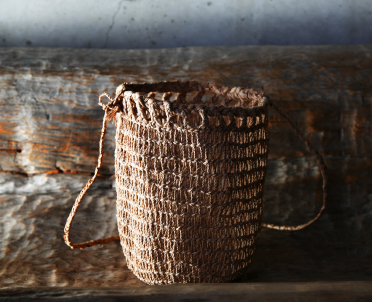
サラニプ
Saranip
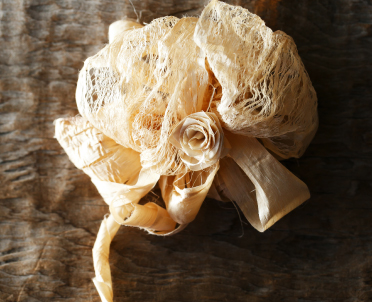
樹皮のコサージュ
Corsage made of Bark
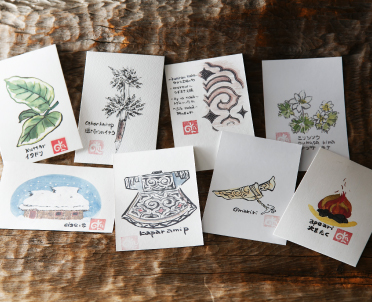
アイヌの絵葉書
Picture postcard of Ainu
貝澤 禮子 Reiko Kaizawa
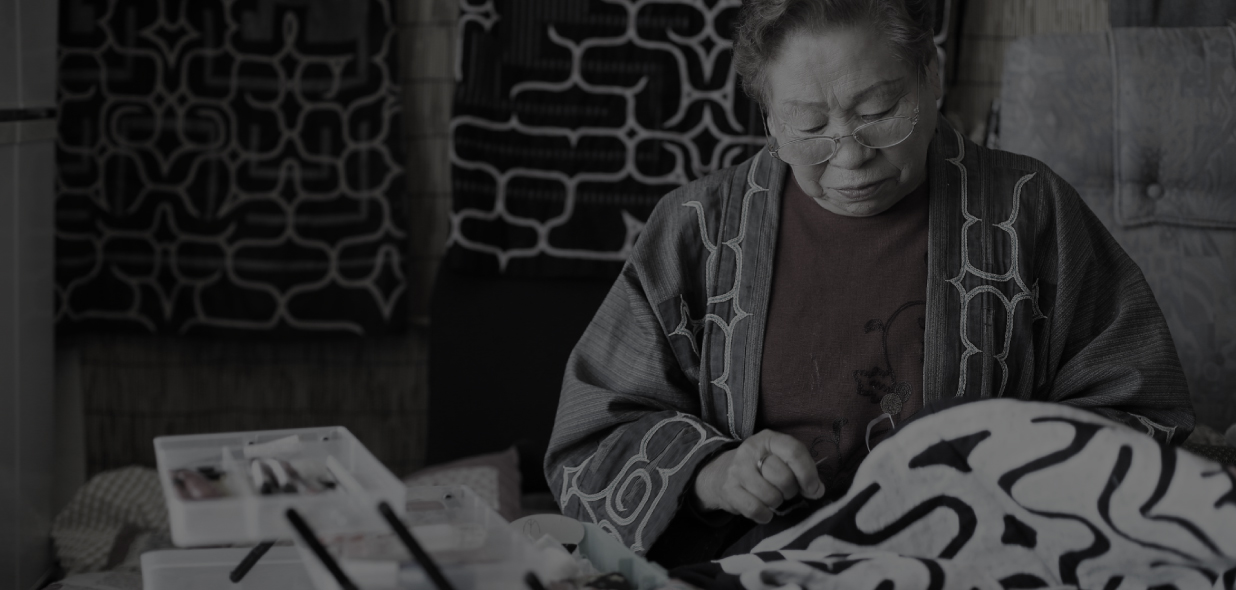
伴侶である故・貝澤福次とともに、1970年から二風谷で創作活動に励んできた。アイヌ文様の刺繍をほどこした着物や半纏のほか、お守り、ストラップ、ブレスレット、アットゥㇱ織などの小物類を手がける。使ってくれる人の幸せを願いながら、1つひとつ丁寧に作っていると、つい時間を忘れて熱中してしまう。
特に、魔除けとして古くからアイヌの生活にとけこんできたイケマの根を布で包みこんだお守りが人気。布や石の色合わせにあたたかみがとけこみ、手にする人たちにやすらぎを与える。伴侶と営んできた『福ちゃん民芸』では、福次氏の木彫り作品(ニポポ、フクロウ、ニマ、髪留めなど)も展示・販売している。
She has been actively involved in creating craft items in Nibutani since 1970, along with her husband, the late Fukuji Kaizawa. In addition to kimono and hanten short coats embroidered with Ainu patterns, she also makes small items such as amulets, mobile phone straps , bracelets and attus textiles. She loses track of time as, engrossed in her work, she carefully creates each item while praying for the happiness of the person who will use it. Particularly popular are the amulets of cloth-wrapped ikema root (Cynanchum caudatum), a plant that from ancient times has been part of Ainu daily life as a protection from evil. There is warmth in the color combination of the cloth and stones she uses, and they soothe the minds of the people who hold them. Fukuchan Mingei is the shop that she ran with her husband, and it also displays and sells his woodcarvings (nipopo dolls, owls, nima bowls, hair slides, and so on).
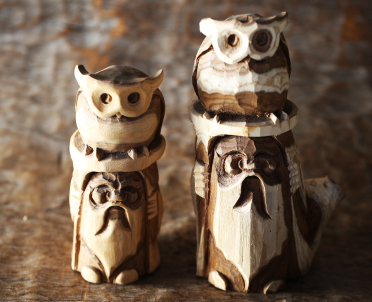
コロポックルフクロウ
Korpokkur

髪留
Barrette
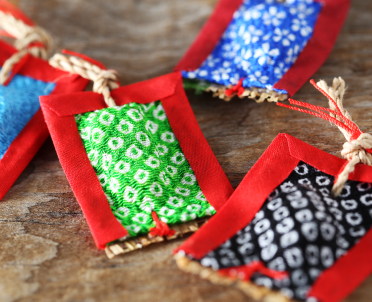
イケマのお守り
Amulet of "ikema"
平村 アキ子 Akiko Hiramura
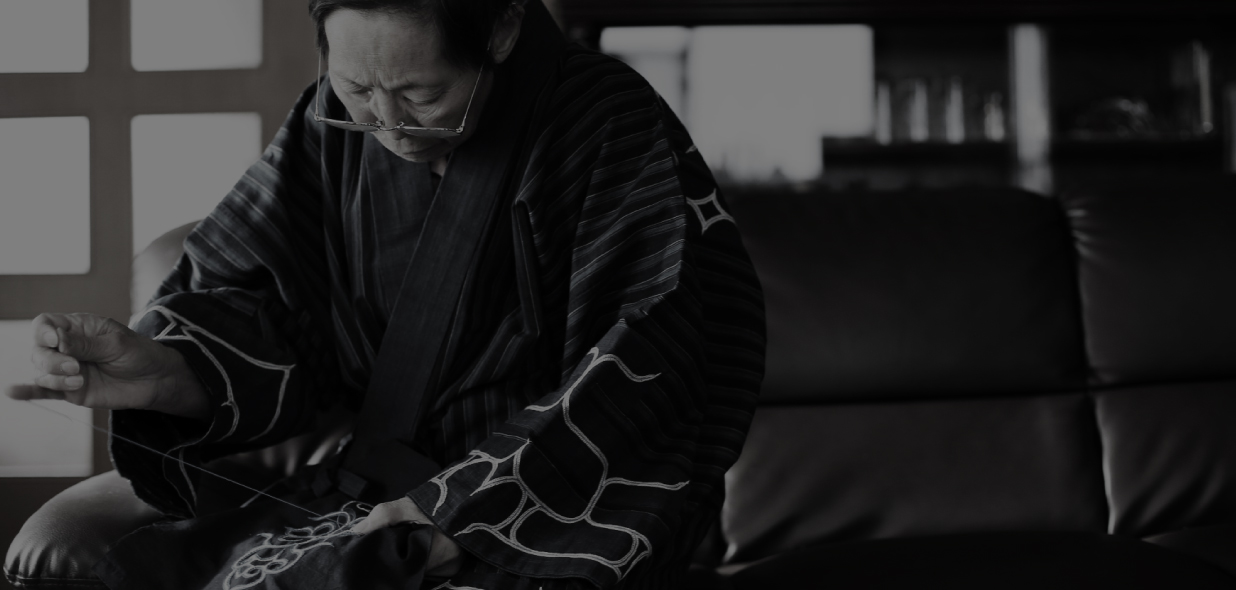
アイヌ伝統文様の刺繍に取り組んでいる。チェーンステッチの目の大きさを揃えながら、一針ずつていねいに縫い上げることを心がけている。また、キラウというツノ(角)をいかにきれいに仕上げるかにこだわるなど、すみずみまで気を配る完成度の高い作品が見る人を魅了する。着物を作るときは、切り伏せと呼ばれる文様を描いた布を貼り付け、その上から刺繍していくが、文様ができあがってくる過程が楽しく、時間を忘れて熱中してしまう。明るい色合いの糸で縫い上げたコースター、ランチョンマット、巾着などの小物類が人気。手にした人が大事に使ってくれるのが、何よりうれしい。7カ月かけて制作したチカラカラペ(着物)で、北海道アイヌ伝統工芸展北海道ウタリ協会奨励賞受賞。
She embroiders traditional Ainu patterns, focusing intently on carefully completing each individual stitch so that each chainstitch is exactly the same size. She is also meticulous in the beautiful finish that she gives to the corners, known as kirau, and visitors are fascinated by the level of perfection of her painstakingly crafted works. When she makes kimono she attaches a cloth with a pattern called kirifuse and embroiders over that. She enjoys the process as the pattern takes shape and becomes engrossed in her work, losing all track of time. Small items such as her coasters, luncheon mats and pouches, sewn with brightly-colored thread, are also popular. It delights her that the people who select them will value them and use them well. She was awarded an Honorable Mention by the Hokkaido Utari Association at the Hokkaido Ainu Traditional Craft Exhibition for a karakarape (kimono) on which she worked for seven months.
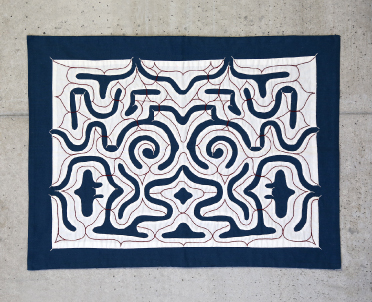
アイヌ刺繍の飾り布
Tapestry of Ainu embroidery
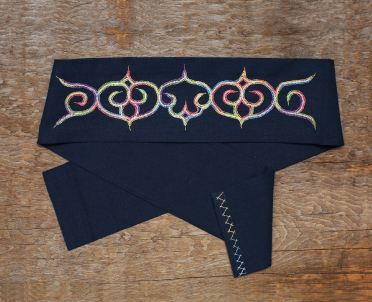
マタンプシ
Matampus
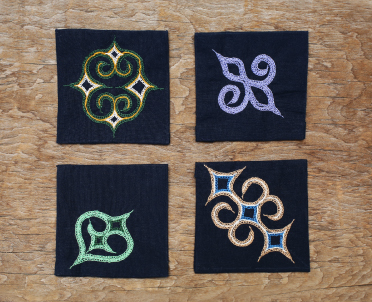
アイヌ刺繍コースター
Coaster of Ainu embroidery
詳しくは下記リンクをご覧ください。(注意)外部リンク
この記事に関するお問い合わせ先
文化財課 文化財係・博物館管理係
〒055-0101
北海道沙流郡平取町字二風谷55番地(平取町アイヌ文化博物館)
電話番号(代表):01457-2-2892
ファックス番号:01457-2-2892
お問い合わせはこちら










更新日:2024年04月19日
公開日:2024年04月01日